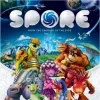Take a look inside 4 images
Spore
Pros: These robust digital-creation tools grab kids' attention and sustain it across multiple stages.
Cons: In the game's later stages, the imaginative creatures and vehicles get bogged down in mundane tasks.
Bottom Line: Spore is a great game for digital creation and design, wherein kids experiment with biological adaptation.
Though Spore doesn't accurately represent evolution, it does capture basic ideas about biology, organisms' needs, and how they interact with their environments. The creation tools can also help kids understand how 3D models are built inside graphics engines.
You can use Spore to teach discrete lessons by having kids play one stage at a time. For example, in a computer drafting or graphics class, you could ask kids to create a few creatures, buildings, or vehicles, and then ask them to reflect on how composing in 3D differs from composing in 2D and how compositing digitally differs from composing physically. In a biology or sociology classroom, you could ask kids to iterate several creatures or civilizations to discover which designs make for the best predators or military societies and which make for the most viable consumers or religious or commercial societies.
If you could design your own unique species, what would it look like? In Spore, players guide the "evolution" of a creature across five stages: cell, creature, tribal, city, and space.
In each stage, the player has to collect resources such as food or spices or Spore's late-game currency, to purchase upgrades that help the creature or its society colonize worlds and conquer or co-opt other organisms and groups. Players can choose to use violence or social measures, such as religious conversion and trade, when evolving. Each stage ends after the player has met the game's growth goals.
The best part of Spore is its creation mode. Players design all of the creatures, buildings, and vehicles they use in the game. The creation tools offer a generous variety of body, building, and vehicle parts that are further customizable by scale, rotation, and color.
Spore isn't meant to teach the science of evolution or biology. However, the game is great for digital creation and very useful for talking about how people and societies meet their wants and needs, as well as for comparing and contrasting gameplay against scientific definitions of evolution, biology, and ecosystems.
Since players act as guiding hands, they influence how creatures and societies change over time according to their own agendas, not any scientific law or theory. There's plenty of room to experiment. Designing buildings and vehicles is enjoyable, but it's not as wondrous as designing a creature. Teachers should note that the game changes about halfway through from being an engaging animal sim to being a real-time strategy game that's about species evolution in the universe. Players can choose to be aggressive (read: violent) or diplomatic.










